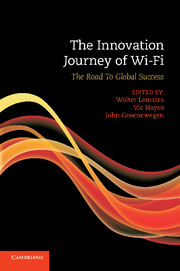Book contents
- Frontmatter
- Contents
- Figures
- Tables
- Contributors
- Preface
- Introduction
- 1 The case and the theoretical framework
- Part 1 The Wi-Fi Journey
- Part 2 The Wi-Fi Journey in Perspective
- 7 Wi-Fi in developing countries: catalyst for network extension and telecom reform
- 8 The Dutch connection to US-based NCR, AT&T, Lucent Technologies and Agere Systems
- 9 Wi-Fi as community-based innovation
- 10 The governance of radio spectrum: licence-exempt devices
- 11 Exploring the future of Wi-Fi
- 12 Reflections and implications for policy and strategy formation
- Part 3 Annexes
- Index
- References
8 - The Dutch connection to US-based NCR, AT&T, Lucent Technologies and Agere Systems
Published online by Cambridge University Press: 05 June 2012
- Frontmatter
- Contents
- Figures
- Tables
- Contributors
- Preface
- Introduction
- 1 The case and the theoretical framework
- Part 1 The Wi-Fi Journey
- Part 2 The Wi-Fi Journey in Perspective
- 7 Wi-Fi in developing countries: catalyst for network extension and telecom reform
- 8 The Dutch connection to US-based NCR, AT&T, Lucent Technologies and Agere Systems
- 9 Wi-Fi as community-based innovation
- 10 The governance of radio spectrum: licence-exempt devices
- 11 Exploring the future of Wi-Fi
- 12 Reflections and implications for policy and strategy formation
- Part 3 Annexes
- Index
- References
Summary
Introduction
In Chapters 2 to 6 the innovation journey of Wi-Fi has been explored and explained as a longitudinal case study, from its genesis in 1985 and subsequent developments until 2008. In Chapters 7 to 11 we take the Wi-Fi journey as a given, and investigate five dimensions of the journey that are of particular interest. In this chapter we look at the ‘Dutch connection’. In acknowledgement of the fact that the Systems Engineering Centre in Utrecht has played such an important role in the development of Wi-Fi, we survey the relationship between the Wi-Fi journey and the Dutch national innovation system (NIS).
From the innovation journey we learned that the development of Wi-Fi was triggered by a policy change towards radio spectrum usage by the US Federal Communications Commission. This new opportunity to use RF spectrum without the need for a licence was taken up by a number of companies, including NCR, to start the development of wireless LANs. The account of the Wi-Fi journey also revealed that NCR's decision to allocate the feasibility study, and later product development, to the Utrecht Systems Engineering Centre was driven by the availability there of the knowledge required to create a wireless LAN. The Dutch connection we explore in this chapter concerns the role played by the Dutch national innovation system in the development of Wi-Fi. In order to do this, we first provide an overview of the Dutch innovation system in terms of its main institutions, and a historical account of RF technology and its applications in the Netherlands. Subsequently we look into the role of the various economic actors and their knowledge interactions that were instrumental in the development of Wi-Fi, and assess how the knowledge that had been acquired in the process migrated to other firms when the Utrecht Engineering Centre was closed.
- Type
- Chapter
- Information
- The Innovation Journey of Wi-FiThe Road to Global Success, pp. 230 - 262Publisher: Cambridge University PressPrint publication year: 2010



